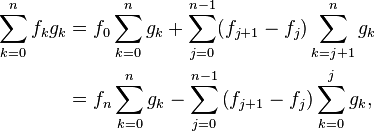Summation by parts
In mathematics, summation by parts transforms the summation of products of sequences into other summations, often simplifying the computation or (especially) estimation of certain types of sums. The summation by parts formula is sometimes called Abel's lemma or Abel transformation.
Statement
Suppose  and
and  are two sequences. Then,
are two sequences. Then,
Using the forward difference operator  , it can be stated more succinctly as
, it can be stated more succinctly as
Note that summation by parts is an analogue to the integration by parts formula,
Note also that although applications almost always deal with convergence of sequences, the statement is purely algebraic and will work in any field. It will also work when one sequence is in a vector space, and the other is in the relevant field of scalars.
Newton series
The formula is sometimes given in one of these - slightly different - forms
which represent a special cases ( ) of the more general rule
) of the more general rule
both result from iterated application of the initial formula. The auxiliary quantities are Newton series:
and
A remarkable, particular ( ) result is the noteworthy identity
) result is the noteworthy identity
Here,  is the binomial coefficient.
is the binomial coefficient.
Method
For two given sequences  and
and  , with
, with  , one wants to study the sum of the following series:
, one wants to study the sum of the following series:

If we define  then for every
then for every 
 and
and
Finally 
This process, called an Abel transformation, can be used to prove several criteria of convergence for  .
.
Similarity with an integration by parts
The formula for an integration by parts is ![\int_a^b f(x) g'(x)\,dx = \left[ f(x) g(x) \right]_{a}^{b} - \int_a^b f'(x) g(x)\,dx](../I/m/0cc4450e2b913b0d32c34fac3ec1aea3.png)
Beside the boundary conditions, we notice that the first integral contains two multiplied functions, one which is integrated in the final integral (  becomes
becomes  ) and one which is differentiated (
) and one which is differentiated (  becomes
becomes  ).
).
The process of the Abel transformation is similar, since one of the two initial sequences is summed (  becomes
becomes  ) and the other one is differenced (
) and the other one is differenced (  becomes
becomes  ).
).
Applications
- It is used to prove Kronecker's lemma, which in turn, is used to prove a version of the strong law of large numbers under variance constraints.
- Summation by parts is frequently used to prove Abel's theorem.
- If
 is a convergent series, and
is a convergent series, and  a bounded monotone sequence, then
a bounded monotone sequence, then  remains a convergent series.
remains a convergent series.
The Cauchy criterion gives
where a is the limit of  . As
. As  is convergent,
is convergent,  is bounded independently of
is bounded independently of  , say by
, say by  . As
. As  go to zero, so go the first two terms. The third term goes to zero by the Cauchy criterion for
go to zero, so go the first two terms. The third term goes to zero by the Cauchy criterion for  . The remaining sum is bounded by
. The remaining sum is bounded by
by the monotonicity of  , and also goes to zero as
, and also goes to zero as  .
.
- Using the same proof as above, one shows that
- if the partial sums
 form a bounded sequence independently of
form a bounded sequence independently of  ;
; - if
 (so that the sum
(so that the sum  goes to zero as
goes to zero as  goes to infinity) ; and
goes to infinity) ; and - if

then  is a convergent series.
is a convergent series.
In both cases, the sum of the series satisfies:

See also
- Convergent series
- Divergent series
- Integration by parts
- Cesàro summation
- Abel's theorem
- Abel sum formula
![\sum_{k=m}^n f_k(g_{k+1}-g_k) = \left[f_{n+1}g_{n+1} - f_m g_m\right] - \sum_{k=m}^n g_{k+1}(f_{k+1}- f_k).](../I/m/c63c7ca95811c6c8cef16b77e89d6501.png)
![\sum_{k=m}^n f_k\Delta g_k = \left[f_{n+1} g_{n+1} - f_m g_m\right] - \sum_{k=m}^n g_{k+1}\Delta f_k,](../I/m/63a949f1656fc3f4ca50231bffb579da.png)










